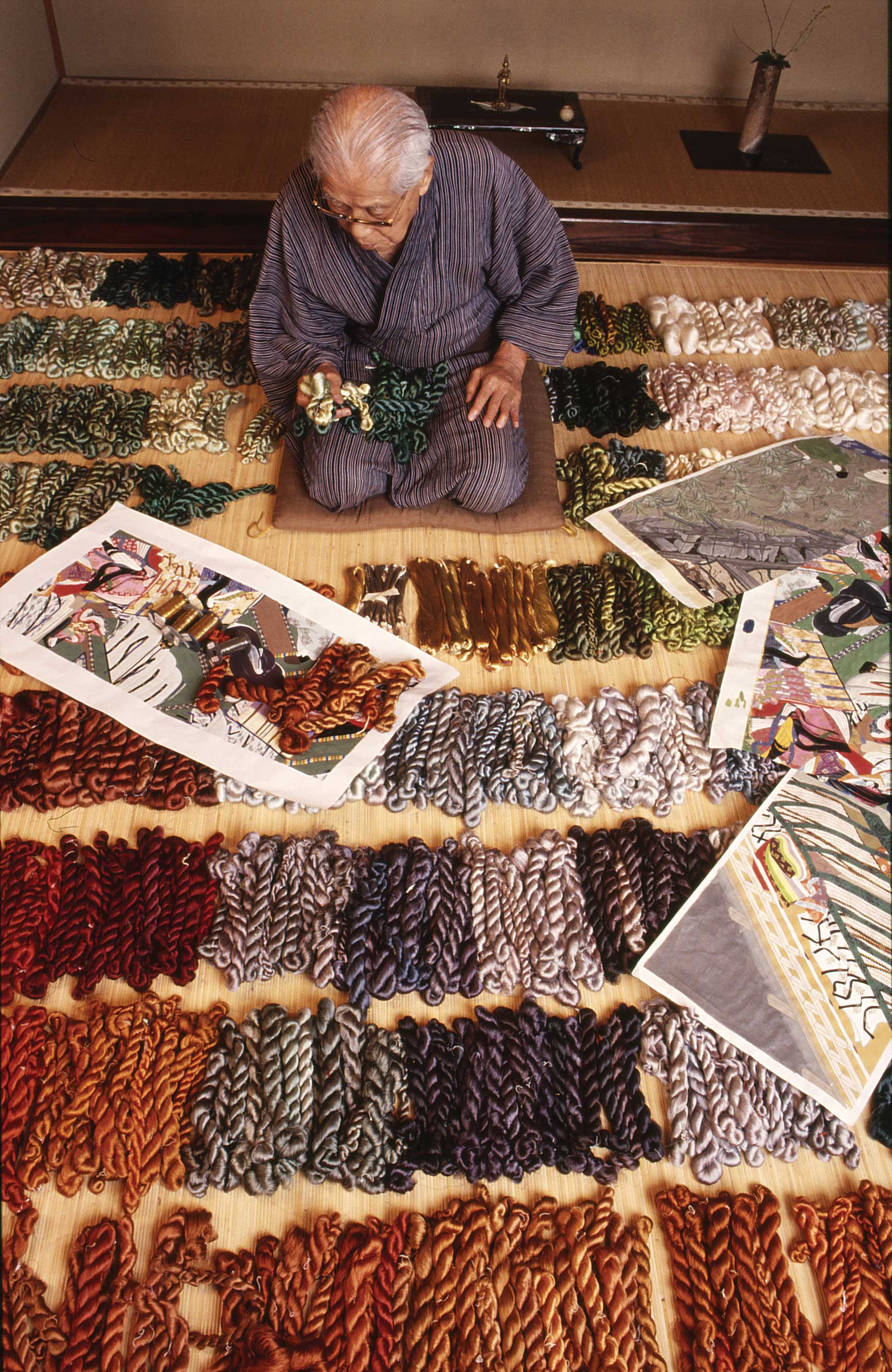The second part of the exhibition exploring visual culture influenced by The Tale of Genji in Paris, is dedicated to Itaro Yamaguchi (1901-2007), a master weaver from the Nishijin district of Kyoto, who wove and donated to the Guimet Museum four scrolls illustrating the epic tale.
These scrolls represent the culmination of a life dedicated to weaving. Made by copying painted scrolls from the Heian period (794-1185) and a hybridisation with the high technicality of Western Jacquard mechanics – and its digital avatar – the four scrolls are on show for the first time together in their entirety. To put the creation of the scrolls into context, they are presented with everyday objects, preparatory drawings and other woven works by the master.
The Silk Weaving Connection Between Japan and France
Since the Renaissance, the city of Lyon has been recognised for the quality of its silk production and weaving. In 1850, a disease, pebrine, decimated the silkworms, threatening to destroy this industry. In steps Japan, which was starting to open its borders again and wanting to position itself as an international silkworm supplier, helping to save Lyon’s silk manufacturing. This trade cultivated strong links between France and Japan, and a number of French delegations were sent to Japan, where some members made their home. In 1872, a Japanese delegation of weavers from Nishijin was also sent to Lyon to study the loom invented by Joseph-Marie Jacquard in 1804.
The history of the Nishijin district of Kyoto dates back to the beginning of the Heian period with the creation of a workshop attached to the imperial court. Under court and aristocratic patronage, Nishijin fabrics was able to benefit from the most advanced weaving techniques of the period. In later centuries, weavers took the initiative of integrating loom into their workshops in order to reduce the cost of production, while increasing yield. By the 19th century, an apprenticeship school was established to teach the principles of Jacquard mechanics. These techniques had certainly been adopted by the Japanese by 1876, when Seishiji Hasegawa designed the first Japanese Jacquard loom in wood with an improved version of his loom being availableby 1896.
Nishijin District of Kyoto
Master Itaro Yamaguchi (1901-2007) was born in into this silk tradition. His family of silk weavers came from the Nishijin district and he was introduced to weaving at a very young age on a Jacquard mechanical loom, notably creating obi (kimono belts). By 1920, he had founded his own silk weaving factory.
After a career spanning 50 years, at the age of 70, Master Yamaguchi decided to ‘leave a masterpiece which would be the embodiment of the highest quality and technicality achieved in the use of the Jacquard loom’. He wanted to show that despite the development of mass industrial production, which according to him hamper imagination, creativity can still exist. After studying The Tale of Genji scrolls, which date from the beginning of the 12th century, in the Tokugawa Museum in Nagoya and the Goto Museum in Tokyo, he decided to reproduce the National Treasure work by devoting the last 37 years of his life to weaving his own immense work.
The Four Tale of Genji Scrolls
Itaro Yamaguchi’s scrolls are composed of two parts: illustrated scenes representing episodes from The Tale of Genji and calligraphies of the text. On most woven rolls, the two elements are made in a technique derived from double-fabric: a superposition of several layers of fabrics woven one above the other which bind together. They are then decorated and the background of the fabric was programmed for the layout, with the design reproduced on graph paper. The preparatory drawings were then enlarged and mounted on screens, which enabled the layout to be made into cards for the loom before stitching the Jacquard boards for the actual weaving. His initial research led him to produce multiple tests, particularly for transparency effects. The master work combines several weaving methods from all over the world to satisfy Master Yamaguchi’s aim for perfection.
Master Itaro Yamaguchi eventually offered these first two masterpieces to the Guimet Museum to thank France for inventing the Jacquard loom which saved the weaving industry in Kyoto. In 2002, the third scroll in turn joined the reserves of the Guimet Museum. The fourth, completed in 2008 by master weaver Kunio Tamura (a disciple and accomplice of the master for many years), completed this remarkable series.
Now, the four rolls are presented together in their entirety for the first time, unrolled they are over more than 30 metres.
On show until 25 March, 2024, part of the exhibition At the Court of Prince Genji, Guimet Museum, Paris, guimet.fr







